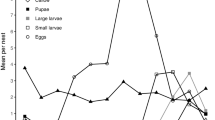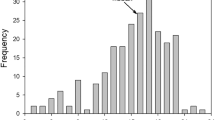Summary:
Dispersal takes place over an extended period in the heathland population of the allodapine bee Exoneura bicolor; some females disperse in autumn and some in spring. This study investigated the consequences of dispersal at different times, particularly the effect of two founding periods on the number of brood and size of pupae, and the relation between adult body size and mortality rate. This is the first time that the effect of differences in the timing of dispersal has been investigated in an allodapine species. Despite at least a 3 — 4 month difference in the time of nest initiation, both autumn‐founded and spring‐founded colonies raised brood at overlapping times. Autumn‐founding females produced a larger number (1.97 ± 0.12, mean ± s.e.) of small brood (2.46 ± 0.60 mg) while spring‐founding females produced a smaller number (1.61 ± 0.08) of large brood (3.05 ± 0.74 mg). Nests initiated in autumn were longer than nests initiated in spring; possibly effecting the relative rate of brood survival in the two cohorts. Smaller adults suffered higher mortality than larger adults. This suggests that the two groups of founders adopt different strategies when apportioning resources among offspring. There was no difference in the weight of male and female pupae produced in the colonies of each founding cohort. Females dispersing in autumn have an advantage over females dispersing in spring as autumn‐founders raise more brood, but this advantage is potentially mitigated by two factors: size‐dependant mortality of smaller adults and the possibility that spring-founding females may gain inclusive fitness by remaining in the natal nest over winter.
Similar content being viewed by others
Author information
Authors and Affiliations
Additional information
Received 30 May 1996; revised 11 November 1996; accepted 24 December 1996.
Rights and permissions
About this article
Cite this article
Silberbauer, L. The effect of non—synchronous dispersal on brood production in an allodapine bee, Exoneura bicolor Smith (Apidae, Allodapini). Insectes soc. 44, 95–107 (1997). https://doi.org/10.1007/s000400050033
Issue Date:
DOI: https://doi.org/10.1007/s000400050033




